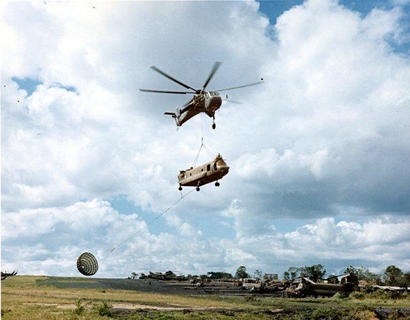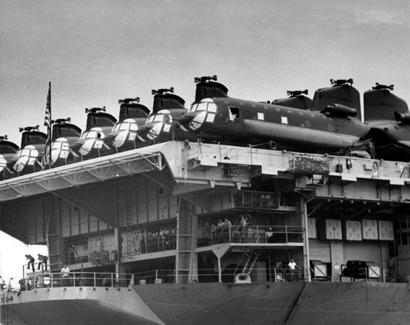|
|
A Shau Valley-
PFC. Caballero
KIA 24 April 1968
YD. 274080
Southeast of Co A Nong Mountain-LZ.-Tiger
In
my feeble attempt to give credence to the loss of PFC. David Joe
Caballero of Corpus
Christi, Texas. I feel it necessary to tell about the A Shau
Valley and the events that led to this battle to come about Operation
Delaware - by the 1st CAV. There are many names of pilots and crewmen
that I should give credit, but there were three most notable. During
this operation was Ralph Jackson CO of B/228, Dave Clemmer, wounded
pilot and Andy Dulay, my co-pilot on April 24, 1968.
The A Shau is a beautiful valley that runs North and South, adjacent
to the Laotian border, just South of the DMZ. It is sparsely populated
by Montagnards, a nomadic people living adjacent to a logging road
#548. The floor of the valley is 2000 ft. above sea level and surrounded
by 5000 ft. mountains.
In 1963 then Captain Colin Powell arrived, serving as an advisor
and he declared it had a French Foreign Legion Quality, Beau Geste,
without the sand. For six months he patrolled the A Shau. Upon his
departure, Special Forces operated a small base camp at the south
end. As part of the Ho Chi Minh trail, the North Vietnamese found
this to be an ideal sanctuary. In 1965, the Marines took over operation
of this area. They established a western base at Khe Sanh plateau,
just north of the A Shau. The North Vietnamese continued to build
supply caches and a hospital complex. This all came to be the staging
area for the NVA (North Vietnamese Army) campaign, Tet’68, initiated
in January.
|
 |
|
CH 47 Skycrane
carrying damaged Chinook
US Army
Photo
|
|
The
battle for control of I Corp by the Marines and 1st CAV. began.
A/228th, a Ch-47 Chinook Company, had recently moved to Hue Phu
Bai on the western edge under protection of the U.S. Marines. PFC.
Caballero, Maj. Don Yenglin and I were new arrivals, days prior
to Tet. After many vicious battles, control of most of I Corp was
under US control with the exception of the Marines at Khe Sanh.
We were all battle weary, but the 1st CAV. fought its way past the
“rockpile”. Leapfrogging firebases up the valley to Khe Sanh plateau,
rescuing a very happy bunch of Marines. The following months of
March and April were spent moving the entire 1st CAV. into I Corp
and lead elements of the 101st ABN Division. The decision had finally
come to mount a large force incursion into the NVA supply base in
the A Shau Valley.
On April 19, 1968 the 1st Cav would air assault into the northern
end of the A Shau and the 101st ABN Division would provide a blocking
force at the southern end of the valley. The first day of the assault
by 1st Cav. resulted in the loss of 25 aircraft of which 5 were
CH-47’s and one CH-54. One CH-47 was mine. This battle would be
extremely intense. My crew was able to be evacuated while I remained
on the ground with the Pathfinder to await another flight. Several
aircraft were able to land, but none were available to take me out.
|
 |
|
Chinooks at
Qui Nhon
To Be Delivered to the 1st Cavalry (Airmobile)
US Army Photo c. 1965
|
|
My Chinook began
to burn and cook off rounds, as we watched the display of fireworks
a CH-54 crane arrived with a sling loaded D7 bulldozer. The C&C
(Command & Control) aircraft were nearby and the crane was told
to drop his load further down the mountain at the valley’s edge.
Unable to satisfactory place the bulldozer down, he moved forward
and into the valley. The Pathfinder was frantic to stop him, but
the instructions were cut out by the C&C aircraft. The crane flew
directly into a 51 caliber machine gun fire. The Pathfinder turned
to me saying, “We lost that crane!” I lost two friends, Art Lord
and Charlie Millard. Another crane flown by Ted Jenkins came in
and dropped a sling load.
After several hours on the ground a supply ship was able to take
me out. A/228th would lose another CH-47 with the loss of all the
crew except the pilots, Don Winskey and Frank Wendt, who were able
to E&E out the next day. We would lose another pilot, Dave Clemmer,
with a leg wound.
On April 24, 1968, Andy Dulay and I would receive a tactical emergency
mission to resupply a 105 firebase SE of LZ Tiger. The unit was
in danger of being overrun. An external load of 105 ammo was rigged
and internally we loaded some classified ammo with additional artillery
troops. Camp Evans was carrying WX 100 ½ with tops at about 8,000
Ft. Our flight plan would be to climb out IFR to VFR on top. We
were then to proceed out to the A Shau and rendezvous with two UH-1
gunships that would escort us down through a VFR (Visual Flight
Rules) hole in the clouds to the valley below..
Since we were close to the Laos border, our descent would be to
rapid spiral down 6,000 ft. to the Valley. The descent was so rapid
and tight we would drift in and out of settling power. The final
approach was from Tiger Mountain, SE. parallel to the valley floor
to the hilltop firebase. On short final we were able to see 4 or
5 UH-1 destroyed aircraft around the boundary of the firebase. Within
50 ft. of the firebase boundary we began to receive small arms fire
directly underneath the left side. This gun fire seriously damaged
the radio compartment and the #1 hydraulic system began to lose
pressure. The left waist gunner took a round just below his armored
chest protector, proceeding upward and killing him instantly. The
crew said he simply crumpled to the floor. They were not sure what
happened to him. There was no room on the helipad to land, so after
dropping the sling load we moved forward to the edge of the pad
touching down our aft wheels, then lowering the rear ramp to unload
the ammo and troops.
We began our ascent with the #1 hydraulic pressure now at zero.
Our altitude would be limited to 6500 ft. just enough to clear the
5,000 Ft. mountains, but we would remain in IFR conditions for the
flight back to Camp Evans. Knowing that an IFR (Instrument Flight
Rules) approach would be required, I began announcing MAYDAY on
both the emergency frequencies. Carl Hess, of B/228th heard the
MAYDAY and relayed our intentions to Evans Tower and that we had
wounded on board. After completing an ADF (Auto Direction Finder)
approach, we landed in the Bravo Co. area and were met by medics.
PFC. Caballero was taken to the hospital where he was pronounced
dead and transferred to the morgue. The aircraft was reviewed by
B Co. Cmdr. Ralph Jackson and his maintenance officer to determine
the flyable status, again we were met by medics requesting that
I come to the morgue for identification and to receive his personal
effects. As I observed PFC. David Joe Caballero, it struck me that
he appeared so small laying on that cot, pale and in a peaceful
sleep. So young - Just a boy! Of all the emotionally difficult things
I've done this would stay with me always!! Tomorrow I would fly
again, the battle would go on. I do not look at the name or personal
effects - I just kept moving.
It would be many years before I would pursue this man's name. My
search taking me through the VHPA (Vietnam Helicopter Pilots Association)
Directory and the national archives, waiting months for the final
answer on the report DA form #1 (Straight Dope Message Board). Thanks
to Julie Klink and Gary Thewlis for their assistance.
This was a tough war for tough young men. Doing their duty in a
war they didn't understand, nor was it appreciated by the American
people. Recently, I participated in a radio talk show in Shreveport,
La. The movie "We Were Soldiers Once" has generated a lot of interest
in those of us that were involved. The public timing may be a little
late, but there is a new generation and if we can find ways to remember
those we lost, such as the final roll call in the movie, recognizing
that these were real young men who's lives were not fulfilled. In
retrospect, most of us have returned to homes, businesses, marrying
and raising children in the freedom they purchased for us. God Bless
them all!!
Thank you for reading this story.
© John R. Fox
They Shoe Horses, Don't
They? Guest
column
June 6, 2014
Related Topics:
Texas | WWII
| WWI | People
| Columns
|
|
|
